 Ramses Maya Add-on
Ramses Maya Add-on
Ramses comes with an official add-on for Autodesk Maya, which actually consists in a Python plug-in and a custom shelf packaged in a simple single module.
It is an example of an implementation of an add-on using the Ramses Python API but it is already well suited for use in production.
As well as all other Ramses Add-ons, the Ramses Maya Add-on includes the main features like versionning, publishing and production tracking with Ramses, but it can be extended to automate your workflow.
This Add-on can be used with or without being connected to the Ramses Daemon (and the Ramses Client Application). If it is connected to the Daemon, it will automatically update the production tracking data.
Installation
- Download and unzip the module.
To quickly deploy the module on several workstations, choose a shared location; the module can then be shared with all workstations and updated at once. - Edit
Ramses.modwith a text editor, and replace the path in the first line with the absolute path where you’ve unzipped the module.
This is how the content of this file looks like:
+ Ramses 0.0.1-dev D:\your\path\to\the\module
PYTHONPATH+:=plug-ins
MAYA_SHELF_PATH+:=shelves
Do not change anything else in the file.
- In order to prevent unintended modifications to the Ramses shelf, you can set its read-only attribute:
- Right click on the
shelves/shelf_Ramses.melfile and selectProperties. - Check the
Read onlybox.
- Right click on the
- Copy
Ramses.modin one of your modules paths
e.g.C:\Users\User\Documents\Maya\modules.
You may need to create the modules folder if it does not exist yet.
Repeat this operation on all workstations where you need the module. - Restart Maya.
- Activate the Ramses plug-in from Maya‘s plug-in manager.
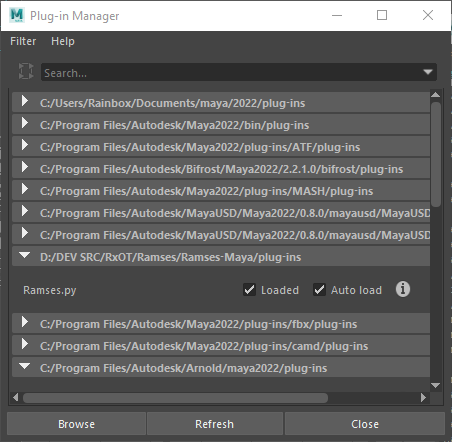
- You may need to restart Maya again so that the Ramses shelf is loaded.
Known Issues
There’s an issue with the Maya Batch Render method where any module adding its own shelf prevents the Batch Render to be processed (as explained here).
There are several workarounds:
- Use a command line for batch rendering:
"C:\Program Files\Autodesk\Maya2023\bin\Render.exe" -proj "S:\path\to\file.mb" - Or use a plugin like this one.
- Or move the Ramses
shelvesfolder (and all other shelves from other module) from the folder where the module is installed to this folder:C:\Users\UserName\Documents\maya\2023\prefs\shelves
Features
All features of the Ramses add-on are available through the new shelf and a marking menu tied to [Ctrl] + [Alt] + [Middle Click]. They are also registered as Mel and Python Maya commands. All these features are detailed in the next sections.
To handle all file naming and sorting, Ramses includes commands to replace all the default Save, Save As and Open functions. Using (almost) only the Ramses commands ensures your files will always be correctly named and in the right location. It also helps Ramses track the production.
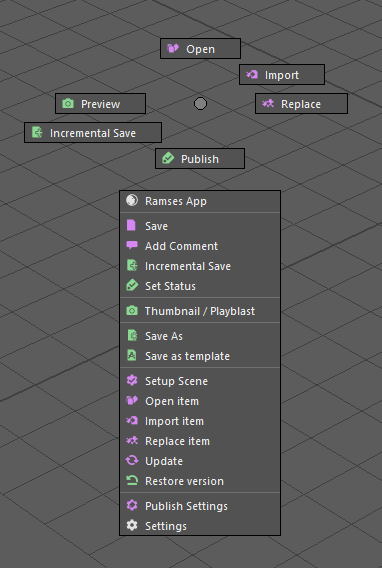
| Feature | Maya Command | Description |
|---|---|---|
ramOpenRamses |
Launches the Ramses Client Application (if its path is correctly set in the settings). | |
ramSave |
Saves and backups the current scene; this save command is also used for production tracking. | |
ramSave |
Associates a comment wit the current scene file. | |
ramSaveVersion |
Saves and increments the version of the current scene. | |
ramSaveVersion |
Saves and increments the version of the current scene, while updating its current production tracking status. Optionally publishes the asset/shot. | |
ramPreview |
Creates a preview (thumbnail or playblast) of the current scene. | |
ramSaveAs |
Saves the scene as a new Asset, Shot or General item. | |
ramPublishTemplate |
Saves the current scene as a new template for the current step. | |
ramSetupScene |
Setups the scene to make it Ramses-friendly. | |
ramOpen |
Opens an Asset, Shot or Template. | |
ramOpen |
Imports an Asset, Shot or Template. | |
ramOpen |
Replaces selected nodes with another Asset, Shot or Template. | |
ramUpdate |
Updates assets and shots included in the scene. | |
ramRetrieveVersion |
Retrieves and restores a previous version of the current scene. | |
ramPublishSettings |
Sets the default publish settings for steps. | |
ramSettings |
Opens the settings dialog for the Ramses Add-on. |
 Save
Save
The Ramses Save command starts by saving the current scene, and then runs a few checks before backuping the file into the _versions subfolder:
- Naming Scheme: checks if the file is correctly named and located. If not, Ramses will run the Save as command instead to ensure the name is correct.
- Version: checks if the version has to be incremented. That’s the case if the current scene is a restored previous version, or if the latest increment occured before the timeout set in the settings.
Depending on these checks, Ramses will automatically associate a comment with the corresponding version to warn of any changes.
The Mel and Python corresponding command is: ramSave. It can take two parameters:
-set_commentor-sc: boolean used to set a comment associated to the current version file.-commentor-c: string is the comment to be associated if-scisTrue.
# Python
import maya.cmds as cmds
# Save the current file
cmds.ramSave()
# Save the file with a comment (show the comment dialog)
cmds.ramSave(set_comment = True)
# Save the file with a custom comment
cmds.ramSave(sc = True, comment = "A new comment!")
 Comment
Comment
The Comment command saves the current scene the same way as the Save command, and adds a comment associated with the current version.
This comment is displayed with the corresponding version in all version selection dialogs, both in the add-on itself and in the Ramses Client Application, as shown below.
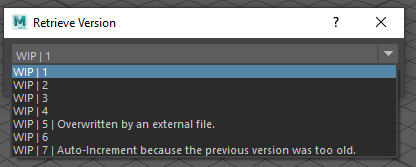

The Mel and Python corresponding command is: ramSave with its two parameters -sc and c. Read the Save section for details.
# Python
import maya.cmds as cmds
# Save the file with a custom comment
cmds.ramSave(sc = True, comment = "A new comment!")
 Incremental Save
Incremental Save
The Incremental Save runs the save command and forces it to increment to a new version.
The Mel and Python corresponding command is: ramSaveVersion with the parameter updateStatus set to False. Read the Update Status section for details.
# Python
import maya.cmds as cmds
# Incremental save
cmds.ramSaveVersion( updateStatus=False )
 Update Status and Publish
Update Status and Publish
The Update Status runs the Incremental Save command and updates the current production status of the current Asset or Shot.
A dialog is shown with a few options to update the status, and to choose to also publish the scene, and create a preview for it. This dialog may differ depending on the use of the Ramses Client Application or not.
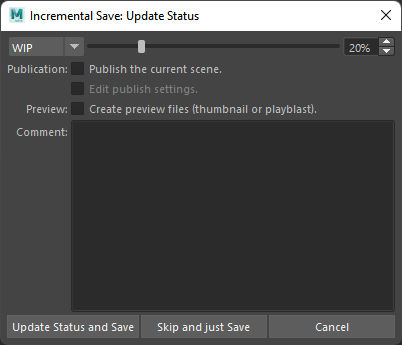
- You can set the new State with the drop down list at the top left; the list of the states is retrieved from the Ramses Daemon.
- The slider and percentage is used to set a new Completion Ratio.
- The Comment field is used to update the comment displayed in the production tracking tools and tables of Ramses.
All this information is automatically fed to the Ramses Daemon which updates the information for everyone.
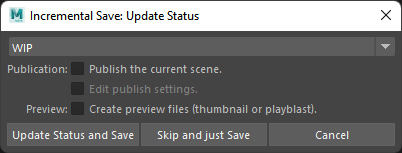
- When not connected to the Daemon, there is still an option to set a State from a default limited list.
- Check the Publication button to publish the current scene.
- Check the Preview button to create a preview (thumbnail or playblast) for the current scene. Read the Preview section for more details.
The Update Status and Save button updates the status, publishes the scene, and creates the preview, while the Skip and Just Save button just increments the version and saves.
The Mel and Python corresponding command is: ramSaveVersion. It can take three parameters:
-updateStatusor-us: boolean. WhenTrue(default), the status dialog is shown to let the user update the status.-publishor-p: boolean activates the publication of the scene.-previewor-pv: boolean activates the creation of a preview.
# Python
import maya.cmds as cmds
# Shows the update status dialog
cmds.ramSaveVersion()
# Incremental save
cmds.ramSaveVersion(updateStatus = False)
# Publishes the file without showing the status dialog
cmds.ramSaveVersion(publish = True, us = False)
# Publishes and creates a preview without showing the status dialog
cmds.ramSaveVersion(publish = True, preview = True, us = False)
Publish
The publication of the scene is done in several steps:
- If the Ramses Daemon is available, Ramses checks if there are publish settings available.
If no settings were found, or if the user checked the box to edit the settings, a dialog window is shown to let the user adjust the publish settings. - The Scene is saved in the
_publishedsubfolder. This is the folder from which the scene and published files can be imported or referenced into other Assets and Shots. - One or several files are published, according to the settings.
- Ramses then calls any potential publish function registered by the pipeline tools or an extension of the Add-On.
▹ Read the publishing guide for Maya for more information about the Maya pipeline.
 Preview
Preview
The Preview command allows you to quickly create either an image (thumbnail) or a video (playblast) preview of the current scene, automatically saved in the _preview subfolder.
There are a few options to adjust how the image or video are rendered.

- Ramses auto-selects the first renderable camera in the scene. To always automatically use the right camera, either add it in the render settings (and remove any other unneeded camera), or check the renderable option in the Ouput Settings section of its attributes.
- The size is a percentage of the resolution of the render settings of the scene.
- You can then adjust all the render options; checking both Only Polygons and Show Motion Trails allows to hide all animation controllers (if they’re curves as usual) but keep the motion trails.
- By default, Ramses overwrites any previous image or video for the current scene, except if you set a new comment when making the preview. Note that the Ramses Client Application uses the preview with an empty comment as a thumbnail to display the asset or the shot in the user interface.
Ramses also automatically burns useful meta-data in the image, like the frame number, the focal length, the comment, etc.

The Mel and Python corresponding command is: ramPreview.
# Python
import maya.cmds as cmds
# Shows the preview dialog
cmds.ramPreview()
Playblasts
When rendering the playblasts, Ramses does not only renders them as usual Maya playblasts: you don’t need to install Quicktime on windows anymore to export videos. Ramses automatically renders the playblasts in a very lightweight MP4 video, crafted especially for reviewing animations, with an intra-frame encoding setting which enables frame by frame playblack on every video player, with great performance.
Ramses will also automatically play the video as soon as it’s encoded using ffplay, a very efficient and lightweight video player. It may seem complicated at first as it does not have any User Interface, but it is easily controlled with a few shortcuts:
- To scroll in the video,
[Right Click]anywhere on the video and drag the mouse horizontally. The left border of the frame represents the beginning of the video, while the right border represents the end. - You can go forwards and backwards with the
[←]and[→]keys of your keyboard by a few frames. - Use
[↑]and[↓]to go to the start or the end of the video. - Use
[Space]to play and pause the video. - Use
[S]for frame-by-frame playing. - Hit
[Q]to quickly quit the player.
 Save As
Save As
The Save As command can be used to create a new Asset or Shot, or save any other new file, while automatically naming and locating it.

- Ramses automatically selects the current Project.
- Select the type of item to save; either an Asset, a Shot or another general item.
- The list of Steps, Asset Groups and Items is automatically built either by asking the Ramses Daemon if the add-on is used with the Ramses Client Application or by looking into the folder structure, but it is possible to create a new one by just entering a new name.
- The Resource is used to differenciate several files for the same Asset or Shot. An empty Resource is considered the main and default working file for the item, but you can add any other file by just adding a small resource name.
When selecting Other as type, the file will be saved in the main folder of the corresponding step. Read the section about the Ramses Tree for more information.
The Mel and Python corresponding command is: ramSaveAs.
# Python
import maya.cmds as cmds
# Shows the save as dialog
cmds.ramSaveAs()
 Template
Template
Use the Template command to create a new template file to be used with a specific step.

Use the Name to have several templates for the same step.
Hint
This command just creates the new template, but does not publish it. You still have to publish it using the Update Status command afterwards.


The Mel and Python corresponding command is: ramPublishTemplate.
# Python
import maya.cmds as cmds
# Shows the publish template dialog
cmds.ramPublishTemplate()
 Setup scene
Setup scene
The Setup scene command runs some checks on the current scene and makes sure everything works according to the current project.
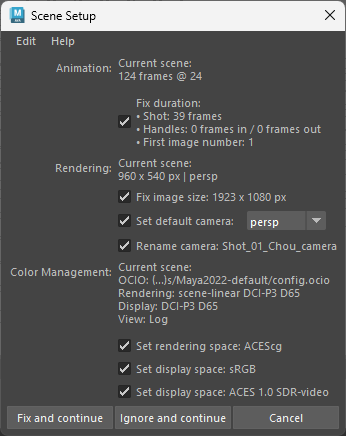
Ramses will automatically add the Ramses_Publish and Ramses_DelOnPublish sets if they’re missing, and checks these values to optionally fix them:
- The frame rate (if the current scene is a Shot)
- The duration (if the current scene is a Shot)
- The rendering resolution
- The camera used in the render settings
- The name of the selected camera
These checks are automatically run when the scene is saved.
The Mel and Python corresponding command is: ramSetupScene.
# Python
import maya.cmds as cmds
# Checks the scene settings and shows a dialog if something is wrong
cmds.ramSetupScene()
 Open,
Open,  Import,
Import,  Replace
Replace
The Open and Import command automatically finds available scenes from your projects.

It is not needed to go down all the hierarchy to select a file to open; if you just select an item and a step, Ramses will automatically open or import the corresponding latest version of the main resource. It works the same way when importing items: you don’t need to go all the way down to select the files you want to import; by selecting just the main file, Ramses will import everything available, or, if you’re using an extension of the Add-on, it will pass all the files to the extension so it can automatically manage the import for you.
When importing an item, Ramses will also trigger custom import scripts registered by the pipeline tools or an extension of the Maya Add-on. This is one way of automating your workflow, by just registering scripts to be called when publishing and importing items.
The Mel and Python corresponding command is: ramOpen. It can take two parameters:
importor-i: boolean. WhenTrue, the dialog is opened in import mode.replaceor-r: boolean. WhenTrue, the dialog is opened in replace mode.
# Python
import maya.cmds as cmds
# Shows the open dialog
cmds.ramOpen()
# Shows the import dialog
cmds.ramOpen(i=true)
# Shows the replace dialog
cmds.ramOpen(r=true)
When importing or replacing items, you can change how the different versions are sorted using the Edit menu.

 Update
Update
Use the Update command to update (or downgrade) the assets included in the scene.

For each asset, you can select which version to use in the scene and automatically replace it. The update command is able to update to a newer or downgrade to a previous version.
The Mel and Python corresponding command is: ramUpdate. It can take two parameters:
updateAllor-a: boolean. WhenTrue, the dialog isn’t shown, and all items are automatically updated.updateSelectionor-s: boolean. WhenTrue, the dialog isn’t shown, and the selected items are automatically updated.
# Python
import maya.cmds as cmds
# Shows the update dialog
cmds.ramUpdate()
# Updates all the items in the current scene
cmds.ramUpdate( a=True )
# Updates the selected items in the current scene
cmds.ramUpdate( s=True )
 Retrieve Version
Retrieve Version
The Retrieve version command can be used to check and restore a previous version of the current scene.

The Mel and Python corresponding command is: ramRetrieveVersion.
# Python
import maya.cmds as cmds
# Shows the retrieve version dialog
cmds.ramRetrieveVersion()
 Publish Settings
Publish Settings
▹ Read the publishing guide for Maya for more information about the Maya pipeline.
 Settings
Settings
Versionning

- The Auto-Increment option sets how many time can be spent before Ramses automatically increments the version of the file when saving. Use this option to be sure you can get back to an earlier version of your work even if you forget to increment the version.
- the Save hotkey option replaces the default “Save Scene”
[Ctrl + S]hotkey from Maya by the Save command from Ramses. This is recommended to enable all production tracking features of Ramses and ensure an automatic backup of your work. Note that checking this box does not replace theFile/Savemenu entry so you can still use the default Maya Save command. - the Save as hotkey option replaces the default “Save Scene As”
[Ctrl + Shift + S]hotkey from Maya by the Save As command from Ramses. Note that checking this box does not replace theFile/Save as...menu entry so you can still use the default Maya Save as command. - the Open hotkey option replaces the default “Open Scene…”
[Ctrl + O]hotkey from Maya by the Open command from Ramses. Note that checking this box does not replace theFile/Open Scene...menu entry so you can still use the default Maya Open* command.
Folders
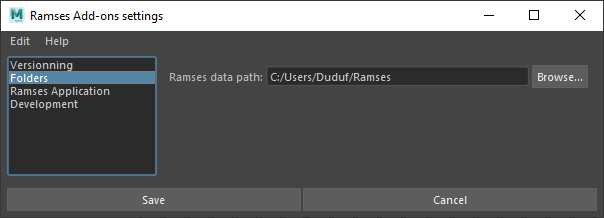
- Set the main Ramses folder location. This is mandatory if you’re using the add-on without the Ramses Client Application.
Ramses Application
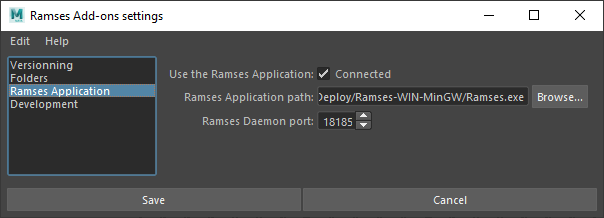
- Check the Connected box so that the Ramses Add-on will work with the Ramses Client Application for production tracking features.
- In order for this to work, you’ll need to set the path to the
Ramses.exefile inside the installation folder of the Ramses Client Application. - The Ramses Daemon Port is the local networking port used by the Ramses Daemon to communicate with the add-ons. It must be the same value as the one set in the Ramses Client Application; the default value is the birthdate of Karl Marx:
18185(May, 5th 1818).
Development
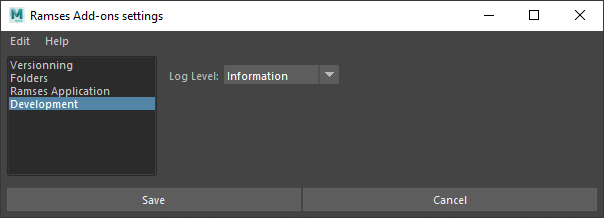
- Change the Log Level to adjust how many information is printed in the console to help you debug your scripts when you’re developping using the Ramses Python API or if you’re extending the add-on.
